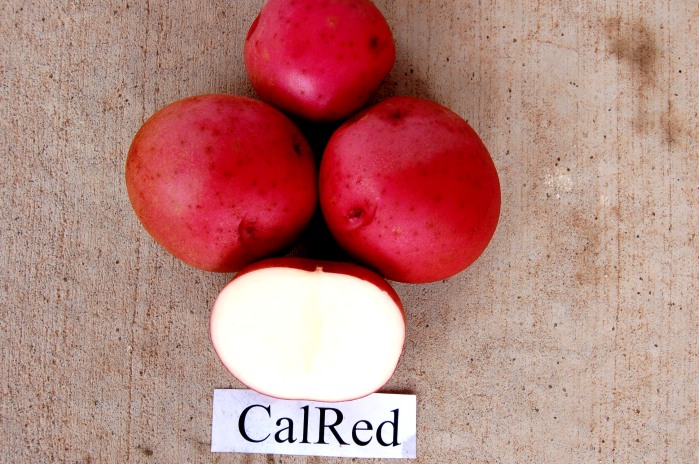
 |
Description | |
| Tuber Shape | Round | |
| Eyes | Shallow evenly distributed eyes | |
| Skin | Red | |
| Flesh | White | |
| Plant | Medium sized upright vine with red-purple flowers | |
Plant/roots This cultivar is slow emerging with a medium vine and red-purple flowers. CalRed has a determinate growth habit and a moderate to shallow, concentrated root system.
Tubers are white fleshed, round and smooth with a bright red skin color; eyes are shallow and well distributed; medium for reds specific gravity (1.077).
Yields potential 300 to 400 cwt. range.
Irrigation Irrigation interval at the maximum ET is 2.5 days. Drought tolerance is moderate. Water use drops dramatically during vine maturation, so careful monitoring is essential to prevent late season overwatering and potential tuber decay caused by Pythium and Phytophthora.
Insects: Standard insect control measures generally are effective.
Fungicides: Control of foliar early blight usually requires two to four fungicide applications.
Tuber/bulking: Tuber set is heavy, somewhat shallow and localized in the hill. Tuberization occurs early and tubers bulk at a rapid rate early in the season. Tuber size in this variety tends to be very even. Tubers are resistant to second growth and moderately resistant to hollow heart, growth cracks and blackspot.
Vine kill: Average days from planting to vine kill are 95 to 105. Vine killing is required in most years; can be easily accomplished once mature. Good skin set occurs within 18 to 22 days.
This cultivar rarely has problems with viruses in the field because of low aphid preference.
Disease reaction ratings susceptible, moderately susceptible, moderate, moderately resistant and
resistant.
Note: This information should only be used as a guide. Adjustments for local conditions must always be made.
Field
Storage Foliar early blight: Moderate susceptible
Tuber early blight Moderate Resistant Verticillium wilt: Moderately Susceptible
Bacterial soft rot Moderate Blackleg Moderate
Fusarium dry rot Moderately susceptible Seedpiece decay Moderate
Leak (Pythium) Moderately Susceptible Leafroll virus Moderately Resistant
Pink rot (Phytophthora) Moderately Susceptible Leafroll Net necrosis Resistant
Silver scurf Moderately Susceptible PVY, PVX Moderate
Rhizoctonia scurf Moderately Susceptible Bacterial ring rot Susceptible
Common Scab Moderately Resistant